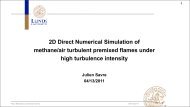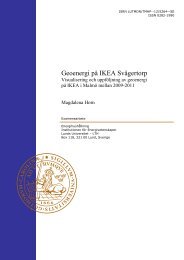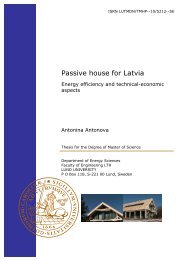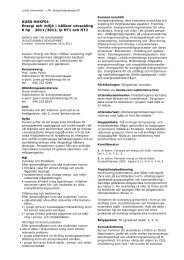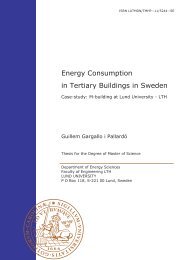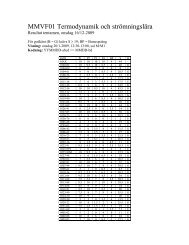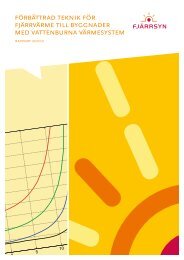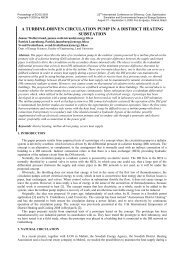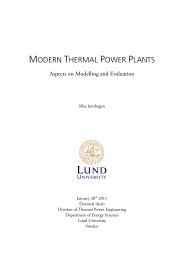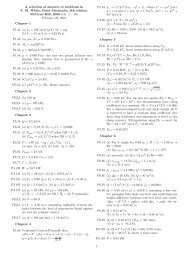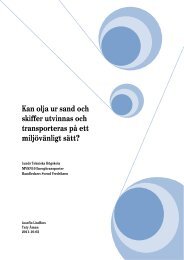Thesis for degree: Licentiate of Engineering
Thesis for degree: Licentiate of Engineering
Thesis for degree: Licentiate of Engineering
Create successful ePaper yourself
Turn your PDF publications into a flip-book with our unique Google optimized e-Paper software.
5 Conclusions<br />
The physics and the transport processes in SOFCs can be described at different length and<br />
time scales. This constitutes a challenge <strong>for</strong> the development <strong>of</strong> multiscale models <strong>for</strong> fuel<br />
cell simulations. In this study, a LBM microscale model was developed <strong>for</strong> the D2Q9 case<br />
(two-dimensional nine speed case). The kinetic model was examined so that no severe<br />
limiting effects on heat and mass transport occurred. Also, a FEM based model <strong>for</strong> an anodesupported<br />
SOFC was developed to better understand the internal re<strong>for</strong>ming reactions <strong>of</strong><br />
methane and the effects on the transport processes. The model was implemented in COMSOL<br />
Multiphysics <strong>for</strong> the analysis <strong>of</strong> three different kinetic models found in the literature. An<br />
equilibrium equation was employed <strong>for</strong> the water-gas shift re<strong>for</strong>ming reaction rate. Parameter<br />
studies were also conducted <strong>for</strong> the methane content and SF.<br />
Five conclusions can be made in this study. First, LBM was found to be a functional method<br />
to microscale modeling predicting the velocity pr<strong>of</strong>ile and mass diffusion well. LBM could<br />
handle both a simple geometry as a channel to a more complex geometry such as a porous<br />
media. For the velocity field, the LBM was able to illustrate the flow correctly around the<br />
obstacles. The mass diffusion <strong>for</strong> hydrogen was reduced from the inlet to the outlet as<br />
expected and contours were seen around the obstacles where mass diffusion <strong>of</strong> hydrogen<br />
occurred parallel to the surface. The detailed in<strong>for</strong>mation from LBM at microscale regarding<br />
the transport processes and chemical reactions can improve the macroscale model by<br />
including this in<strong>for</strong>mation <strong>for</strong> the TPB areas.<br />
Second, it was shown that the reaction rates were very fast and differed slightly across the<br />
three models due to the great differences <strong>of</strong> the pre-exponential value and the activation<br />
energy. The model was found to be sensitive to variation <strong>of</strong> the steam re<strong>for</strong>ming reaction rate.<br />
Both the inlet temperature and active surface area to volume ratio showed an effect on the<br />
reaction rates in terms <strong>of</strong> the maximum value.<br />
Third, it was found that a fuel containing a high percentage <strong>of</strong> methane in combination with a<br />
high inlet temperature produced a steep temperature gradient close to the cell inlet. Fourth, a<br />
higher steam-to-fuel ratio showed a decreased risk <strong>of</strong> carbon deposition at the anode catalytic<br />
active area.<br />
Finally, there was no direct significant risk <strong>for</strong> heat and mass transport limitations <strong>for</strong> the<br />
SOFC model with the kinetic parameters in this study. Care should be taken if the reaction<br />
rate is increased since this will affect almost every criterion in the analysis. It transpired not to<br />
be sufficient only to describe the reaction rates with a few empirical parameters. It was<br />
necessary to develop a suitable microscale model <strong>for</strong> the SOFC. However, the global kinetic<br />
models have still predicted valuable behaviors. The reason why the kinetics models differed<br />
to a large extent is that they were sensitive to how the experiment was designed.<br />
51



